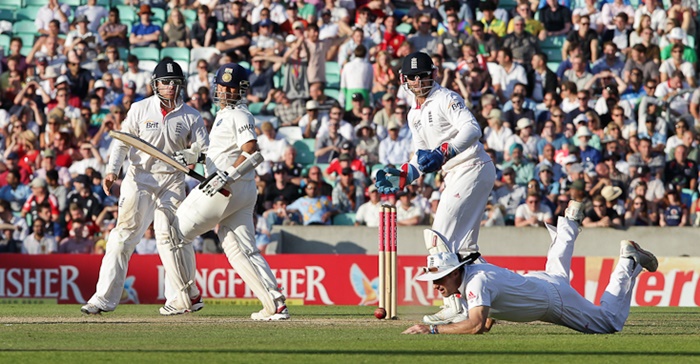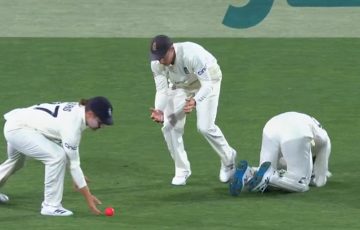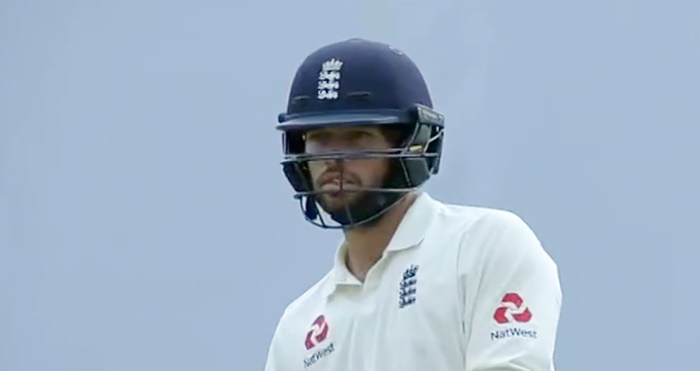
The Cricket Monthly has a wonderful article on how dropped catches impact a Test. It’s a fascinating subject for how poorly it’s currently understood.
Two of our favourite facts from the article are:
- That Wavell Hinds was once dropped twice en route to a duck – surely a candidate for the worst Test innings there’s ever been
- James Tredwell suffered 10 missed chances in his two-Test career
The second brings to the fore an obvious point. Except for caught-and-bowled opportunities (which accounted for three of Tredwell’s missed opportunities), at the moment at which a catch is there to be taken, the bowler has done all they can.
In many ways it makes more sense to gauge a bowler’s worth by how many chances they create rather than how many wickets they take. Everything beyond that is out of their hands (and quite often out of the fielder’s hands too).
Tredwell still managed to take 11 wickets in those two Tests, incidentally. It’s intriguing to ponder how his figures could have looked given less buttery fingers among his team-mates.
The cost of a drop
To produce the article, Charles Davis spent Godfrey Evans knows how much time logging dropped catches. He found that roughly a quarter of chances are grassed.
It strikes us that if you take the average number of chances in a match and the average number of wickets and runs in a match, you can arrive at some sort of standard value for a wicket-taking opportunity through which we can measure the worth of a bowler.
So what is the average number of chances per match?
In the last 10 years (at the time of writing) 441,749 runs have been scored and 12,841 wickets have been taken. Of those wickets, 8,026 have been catches.
As per Charles Davis’s figure, we’ll assume that a quarter of chances are dropped, so 8,026 catches equates to 10,701 chances – an additional 2,675.
In other words, to take those 12,841 wickets, around 15,516 chances were created.
This means that for 441,749 runs, each wicket-taking opportunity is worth 28.47 runs.
What does this mean?
Doubtless there’s more than a soupcon of wonk in those calculations – mathematics isn’t our strong suit – but surely someone with more time and a better brain can arrive at a reasonably accurate means of measuring the run value of every ‘chance’.
Yes, there’s an obvious difference between the value of a Wavell Hinds drop and a Brian Lara drop, but who’s to say what might happen next in any given situation? The whole point of averages is to take such things out of the equation.
What’s the cost of a drop? About 28.47 runs, on average.
We’re particularly interested in what this means for wicketkeepers. The trend at present is to place great emphasis on batting and someone likely to average 10 runs more an innings (20 runs a match) will pretty much always get the nod.
However, if each wicket-taking opportunity is typically worth 28.47 runs, that run-scoring difference amounts to significantly less than a single dropped catch per Test match.




There’s been some work done on this in baseball, where fielding errors are not ‘charged’ to the pitcher’s “earned runs”, but that’s more about runs conceded than wickets (or ‘outs’). It’s tricky to know for definite that the ‘average fielder’ (at whatever level, First Class, Test, or Village) would have taken a given catch. Ultimately no two chances are ever going to be exactly the same, so you have to use judgement to some extent, but theoretically there could be a ‘replacement level fielder’ to compare any given team’s fielders to, and the bowling performance could be indexed against that.
All of this would pale in comparison to other factors like the pitch the match is being played on, the weather, etc, which are always going to skew statistics anyway, so the main lesson is to be carefula bout viewing stats (whether bowling average, batting average, conversion of 50s to 100s, etc) as having any ‘absolute’ meaning.
In general, the cricket community (ie, cricket fans, cricket journalists and cricketers) seems to fall into the trap of thinking that numbers are somehow more ‘accurate’ or ‘objective’ than words. Numbers are just another way of describing things. Someone’s batting average is an indicator of how good at batting they are, but it’s not an infallible measure.
All else being equal, a bowler who produces more chances will take more wickets – and ‘missed chances’ may actually contribute to the taking of wickets, by making a batsman change his approach or by inspiring fielders to ‘make up for’ missed chances by upping their level of concentration and/or physical commitment.
There is of course nuance to even the more accepted statistics and it is unarguably foolish to take any as having an absolute value. There is however a gap when it comes to fielding and in particular wicketkeeping, where we don’t even have a base metric to take issue with.
It’s just purely unknown, which leads to people assigning greater value to runs scored than chances missed on the grounds that it’s so much easier to measure. We think even a pretty ordinary stat assigning some sort of value to catches/drops would help address this.
I wouldn’t disagree. In fact, I may even agree. I don’t think it’s controversial to suggest that better fielding stats are needed, but so far there hasn’t been much evidence of wide adoption of any particular stat (as far as I’ve seen, anyway).
Something simple like wickets taken as a proportion of chances created would undoubtedly be possible, but would of course still be subject to potential disagreement about what counts as a ‘chance’. Plenty of other sports deal with ambiguity in stats (eg football or hockey ‘assists’), so it’s not a deal-breaker that some judgement would be involved.
Being as we’re not MS Dhoni, we don’t need something to be 100 per cent accurate before we perceive it to be of any use at all. We think a rough value for a dropped catch would come in handy when evaluating players.
A rubbish outfielder could easily end up with better fielding stats than a skilled slip or silly fielder, because it is easier to catch a skied one than to pull off a miracle catch. It is all rather complicated.
Dropped catches can have the opposite effect, whereby they cause the fielding site to become increasingly frustrated (especially if compounded) and ultimately demoralised.
Consideration should also be given to comedy fielders, e.g. Monty, and the crowd’s reaction/interraction should another steepling chance be heading towards him on the boundary; this would further depend on whether it was a home or away crowd…
There is no cricket viewing emotion quite so intense as Monty under a second steepler.
On the Tredwell point, it’s also handy to consider how a bowler’s wickets are taken.
The other day I told my wife Jake Ball had taken five wickets in an ODI. Her response, quick as a flash, was to ask: “How many of those were the top order?”
Exactly, Sam. And there are many more variables as well. If a dropped catch is a wicket-taking ball as far as the bowler is concerned, what is a full toss miss-timed and chipped to mid-on? Maybe that shouldn’t be a wicket, and the bowler should have six runs added instead. Sometimes, played on is due to a ball nipping back beautifully. Other times it is a batsman who tries to smack a wide long hop.
Overall I reckon that bowlers get as many wickets from bad balls as they lose from dropped catches. That’s a guess, of course, but I’m sure I could prove it with some research.
Right, I’ve done the research. It turns out that in the history of cricket there have been 483,677 (*) dropped catches, while over the same period there have been 967,356 (*) wickets taken with filth. However, exactly half of these latter were taken by Ian Botham after he got a mullet, leaving approximately 483,678 (*) wicket-taking bad deliveries for all the other bowlers. So it turns out I am right because of maths.
(*) Trump for President!
How many wickets have been taken with balls that were absolute pies, only to be proved retrospectively (i.e. in the absence of an on-field review) to be not out by DRS? I’m thinking specifically of the Graham Swann ass-high full toss to Chris Rogers in 2013 here, but there must have been others.
Known as Graeme Swann by all but his closest mates.
7
Does any of the above apply in the chance vacuum that is test cricket in the UAE?
Pakistan usually manage to create plenty.
I’m impressed how you grossed up the 8026 wickets by 100/75. A lesser man may well have just added 25%.
Yes, our major mathematical weakness is actually just an inability to reliably add up.
…and an ability reliably to split infinity?
Ooh, bet you’re (justifiably) proud of that one.
Don’t we already have a way to measure the cost of a drop – the difference between the batsman’s eventual score and the score he was on when he was dropped? That would also eliminate the difference between dropping Wavell Hinds en route to 0 and Lara en route to 400.
That said, the stat would run into trouble when a batsman was dropped more than once. Tendulkar was once dropped 4 times by 4 different Pakistani fielders en route to a match high 80-odd in the 2011 World Cup Semi final. If you applied the same measure to all four drops, the aggregate cost of all 4 drops would end up being higher than the batsman’s total score.
I’m all in favour of the bowlers “chances created” stat though. Pakistani bowlers in particular would be delighted.
The point is that the vast majority of what happens after a drop has nothing to do with the fielder involved.
If you were trying to gauge the quality of two wicketkeepers and one had dropped Brian Lara and one had twice dropped Wavell Hinds, you wouldn’t use runs as your measure – you’d use number of drops. The point in assigning some sort of standard value to a drop is that it then allows you to set that against the two players’ run-scoring with the bat.
Fair point.
Having now read the Cricket Monthly article as well, I guess you would also have to factor in the “difficulty” level when keeping to spinners as opposed to keeping to pace bowlers.
Totally agree that chances should be monitored/recorded and stats based on that too. Before umpires decisions were reviewed there was the added element that there was a much larger proportion of wrong umpiring decisions. The lack of “corrected” stats put at risk players careers at times (or benefit them luckily) so back nearly a decade ago I started recording “real averages” for batting.
I don’t keep the blog up any more so unfortunately not all the links on this page work but it’ll still give you an insight into real averages – Alastair Cook was an early beneficiary of lots of luck you’ll see. http://cricketburble.blogspot.co.uk/search/label/real%20averages?m=0
[Sidenote: Personally I want a batsman’s leg byes to be recorded – I can’t play the leg glance but i’ve perfected ways of waving the bat somewhere near the ball and getting my team runs by either the traditional left pad glance down to fine leg, or the more audacious right pad glance which involves the Pietersen flamingo, the right pad ending up swinging out to the leg side, and getting the ball down to fine leg off the right shin or in-step. I feel I should get credit for these “runs” somehow – it’s far harder to do it my way than these ponces who simply get their bat in the correct place at the right angle!]
Interesting stuff. We understand how a player’s ‘real average’ might end up being lower than their actual average, but how did you calculate those that ended up higher? How do you allocate runs to someone when they’re sawn-off?
Ed Lamb has a proper face for his avatar
Get him!
In what way is Ed’s face “proper”, whereas yours and mine are not, Sam?
…and please don’t give me the “Sam and Ged’s photos have some antiquity on them” argument; Ed Lamb is in fact 79.
I wish I didn’t have my proper face for my avatar
While it could be important to keep track of chances and drops in order to measure a fielding performance, I don’t think being the beneficiary of a dropped catch makes a batsman ‘lucky’. At least not more so than any other way run scoring becomes easier, anyway.
Dropping a catch is just one of many ways that a fielding side can be too poor to dismiss a batsman on that particular delivery. Other methods include bowling wides, standing in the wrong place or bowling terrible balls that get easily smashed for four.
If a batsman is ‘lucky’ to be dropped then he is also ‘lucky’ when a bowler drops short or the opposition captain brings Jade Dernbach on.
Dew buggering up the inaugural subcontinental day-night Test, it sounds like. Not that the pitch hadn’t tried its best to bugger it up already.
The answer is: 42
Sounds like you put some Deep Thought into that.